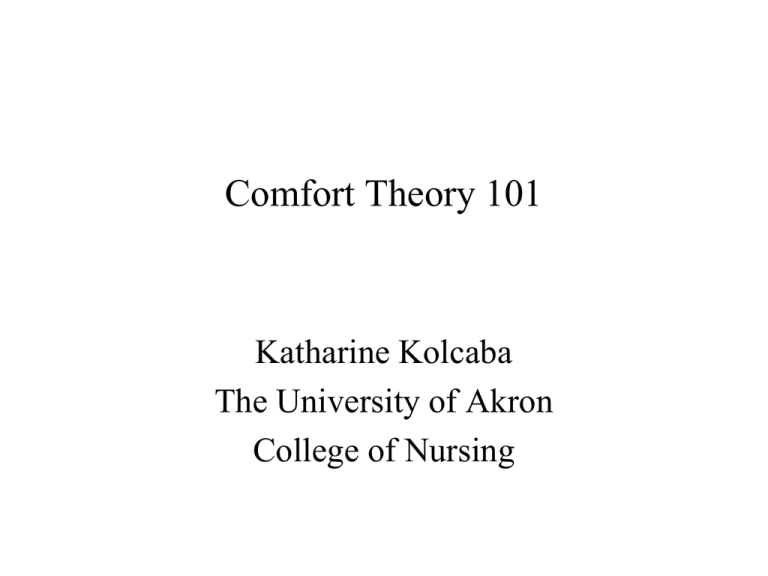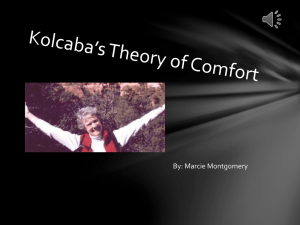Comfort Theory: A Framework for Healthy
advertisement

Comfort Theory 101 Katharine Kolcaba The University of Akron College of Nursing What do we mean by comfort? • Complex term • Common use • Technical definition (Kolcaba, 1992) • Strengthening component (rationale for comforting interventions in both populations) Dictionary Definitions: Comfort (Webster) • 1. To soothe in distress or sorrow. • 2. Relief from distress (absence of previous discomfort) (negative sense) • 3. A person or thing that comforts • 4. A state of ease and quiet enjoyment, free from worry (neutral sense) • 5. Anything that makes life easy • 6. Suggests the lessening of misery or grief by cheering, calming, or inspiring with hope (positive sense) • verb, noun, adjective, adverb Relief I need help because I’m lonley. Relief Ease I feel totally peaceful. Transcendence I did it! (with the help of my coach…) Research Study: Comfort in LTC setting (Hamilton, 1989) • Research questions: • • • • • What is the residents’ definition of comfort? What contributes to the residents’ comfort? What detracts from the residents’ comfort? How can residents become more comfortable? (Qualitative study) Five recurring themes: Physical Comfort homeostasis, pain relief, symptom management • 2001: Data from more than 2.2 million nursing home staff who usually underestimate true pain burden of residents. • Woefully inadequate pain management among frail and old population of Americans. • Positioning – Returning to bed when requested – Better seating arrangements But physical comfort and positioning isn’t the only important type of comfort • There are three more comfort themes that the participants in this study cited… Comfort theme of self-esteem (psychospiritual) Comfort theme of approach and attitudes of staff (sociocultural) Comfort theme of hospital life (environment). Definition of Holistic Comfort Relief Ease Transcendence Physical PsychoSpiritual SocioCultural Environ -mental (Kolcaba, 2003) Technical definition of Comfort (cont) • The state of being strengthened when needs for relief, ease, and transcendence are met in four contexts of experience: physical, psychospiritual, sociocultural, and environmental • Nice fit with nursing practice and research! Comfort Theory (3 parts) • Comforting interventions enhance patients’ comfort. • Enhanced patient comfort is positively related to engagement in HSBs – Comfort is strengthening • When patients (and families) engage in HSBs, institutions have better outcomes – Patient satisfaction, nurse retention, costs down Practical Application • Holistic assessment of patients’ comfort needs – Use grid as a guide • Holistic interventions to meet those needs. – Use grid as a guide • Relationship of comfort (holistic outcome) to health seeking behaviors (HSBs) – External HSBs: e.g. functional status, rehab progress – Internal HSBs: e.g. healing, t-cell counts, etc. – Peaceful death: perfect for hospice and palliative care • Holistic instruments to determine outcomes • Institutional outcomes: increased patient satisfaction, decreased cost, decreased readmissions, etc. • Don’t forget about comfort of nurses! • Kolcaba, K. (2003). Comfort Theory and Practice. Springer. • Available at: – www.uakron.edu/comfort – www.SpringerPub.com – www.Amazon.com






